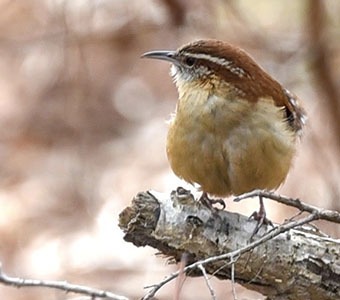Brush piles can provide important habitat for songbirds, lizards, snakes, rabbits, and other small mammals. While brush piles are sometimes thought of as “ugly,” they don’t have to be. There are some beautiful, native flowering vines which can be encouraged to grow over the brush pile. The flowering vines are also likely to attract pollinators, and thus provide foraging habitat for additional animals. Some people have even used brush piles covered in vines to create a type of living property fence.

Before starting a new brush pile, take a couple of minutes to answer a few questions.
1) Are you allowed to have a brush pile on your property?
Depending on where you live, you may need to find out if having a brush pile is even a possibility for you. Some cities and subdivisions have ordinances or laws against maintaining brush piles on your property.
2) Where do you want to place the brush pile?
Remember that the purpose of the brush pile is provide places for songbirds, lizards, snakes, and rabbits or other small mammals to hide, hunt, and live. While lizards, snakes, and small mammals play crucial roles in the ecosystem, inviting them to move into our homes is typically not a good idea. So, plan to put some distance between the brush pile and your house, garage, shed, or other buildings. And, please don’t put it near your neighbor’s house, garage, shed, or other buildings. Inconsiderate actions like that are part of the reason why we have to ask question #1.
3) What do you want your brush pile to look like?
As a general rule, larger brush piles tend to be more effective than smaller brush piles. However, you can start small and add to your brush pile over time. Brush piles can be as simple as a loose pile of sticks and limbs that you’ve picked up from around the yard. They can also be much more complex and incorporate multiple tree trunks to create a tick-tack-toe type grid or a long fence. If you do an internet search for “how to create a brush pile for wildlife,” then you’ll be able to find all kinds of information about creating different styles of brush piles. As I mentioned before, flowering vines can also be grown over the brush pile to make it attractive to pollinators as well.
While brush piles are not appropriate for every backyard, they can provide valuable habitat for a wide variety of animals if you have space for them. So, the next time you are picking sticks up from your yard, or have a tree fall in your woods, I encourage you to consider whether creating a brush pile might be a good option for your property and wildlife habitat.

This article was part of Shannon’s original Kentucky Pollinators and Backyard Wildlife blog which evolved into the blog for Backyard Ecology.

Backyard Ecology: Exploring Nature in Your Backyard
Nature isn’t just “out there.” It’s all around us, including right outside our doors. Hi, my name is Shannon Trimboli, and I am the host of Backyard Ecology. I live in southcentral Kentucky and am a wildlife biologist, educator, author, beekeeper, and owner of a nursery specializing in plants for pollinators and wildlife conservation. I invite you to join me as we ignite our curiosity and natural wonder, explore our yards and communities, and improve our local pollinator and wildlife habitat. Learn more or subscribe to my email list at www.backyardecology.net.

Leave a Reply